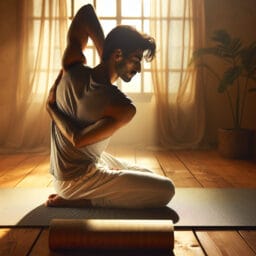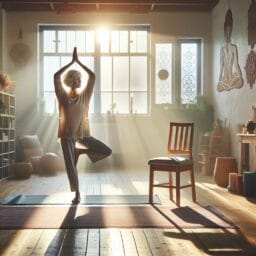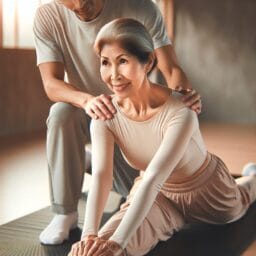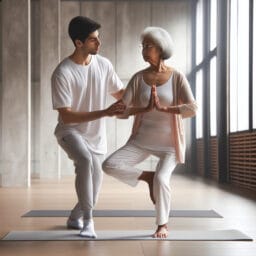
10 Gentle Yoga Tips for Seniors to Improve Flexibility and Balance
Table of Contents
- Introduction
- Tip 1: Start with Gentle Warm-Up Exercises
- Tip 2: Focus on Breathing Techniques
- Tip 3: Use Props for Support
- Tip 4: Incorporate Chair Yoga
- Tip 5: Practice Balance Poses Gradually
- Tip 6: Modify Poses as Needed
- Tip 7: Engage in Regular Practice
- Tip 8: Attend Senior-Friendly Yoga Classes
- Tip 9: Pair Yoga with Other Exercises
- Tip 10: Stay Hydrated and Nourished
- Conclusion
- Frequently Asked Questions
Introduction
As older adults integrate yoga into their daily lives, the benefits extend beyond mere flexibility and balance; it becomes a holistic tool for rejuvenating the mind and body. Engaging in yoga practices like mountain pose while taking deep breaths can significantly boost upper body strength and circulation, proving invaluable for those with limited mobility. Chair yoga exercises offer a great option, allowing participants to remain seated while stretching painful muscles and reducing stress—this is especially important for individuals who may have health issues that constrain them to less strenuous activities. Incorporating these exercises daily not only improves physical health but also calms the nervous system, creating a healthy lifestyle routine that builds strength and boosts balance. The guidance of a seasoned yoga teacher can introduce modifications that make yoga accessible regardless of physical limitations, ensuring every senior has the chance to embark on a rewarding yoga journey. With regular practice, this age-old discipline unfurls wonderful health benefits, from loosening stiff joints to improving heart rate variability—a testament to its adaptability and enduring value in promoting wellness among older adults.
Tip 1: Start with Gentle Warm-Up Exercises
Delving deeper into the essence of an enriching yoga routine, it’s imperative for older adults to initiate their sessions with a sequence of gentle warm-up exercises. This approach is not merely a preamble to the more intricate poses but serves as a critical measure to awaken the muscles and enhance circulation, effectively averting potential injuries. A good warm-up might include shoulder rolls that release tension in the upper body, followed by simple seated twists to stimulate the spine—both integral components for cultivating a supple framework conducive to yoga practice. Additionally, leg lifts can be incorporated to engage lower body strength gradually—a stepping stone towards stability during standing poses later in the session. These initial movements are vital in preparing both mind and body for the tranquility and exertion that follows, enabling older practitioners to transition smoothly into their yoga journey while cherishing each breath and stretch. With modifications readily available, these preparatory steps ensure that every individual embarks on their path to wellness from a place of safety and personal comfort, regardless of physical limitations or health issues.
Tip 2: Focus on Breathing Techniques
Amid the serene tranquility that yoga provides, older adults uncover a rhythmic flow wherein breath becomes an anchor for both mind and body, orchestrating a harmonious balance pivotal to their practice. Breathing exercises – pranayama – are the subtle yet powerful currents beneath the surface of every pose and transition, serving as tools to deepen relaxation and sharpen focus. Seniors can integrate simple techniques such as diaphragmatic breathing, where deep inhales expand the belly rather than the chest, or the calming Nadi Shodhana – alternate nostril breathing – which harmonizes both hemispheres of the brain. These practices bolster the nervous system and heart rate regulation while mitigating stress; they are especially beneficial when holding poses like cobra pose, enhancing upper body strength with each mindful breath. By incorporating these nuanced methods daily into their yoga routine, older adults not only fortify their physical health but also cultivate an inner sanctuary of calmness, making modifications make yoga accessible even in the face of health issues or limited mobility. This holistic approach ensures that each yoga journey is not just about stretching painful muscles or improving circulation but about nurturing a healthy lifestyle that reverberates through all facets of well-being.
Tip 3: Use Props for Support
Yoga’s versatility shines when props are introduced, offering older adults an opportunity to experience poses with greater comfort and stability. Blocks, straps, and cushions serve as invaluable allies in a senior’s yoga practice, ensuring that physical limitations don’t hinder the pursuit of flexibility and strength. A block placed under the hand can reduce the strain on joints during triangle pose or support the back in a restorative bridge pose. Straps become extensions of the arms, bringing the benefits of stretches within reach regardless of flexibility levels—think seated forward bends where a strap looped around the feet invites calmness without compromising form. Meanwhile, cushions elevate hips in cross-legged positions to alleviate pressure on the knees and encourage a more comfortable seated posture for pranayama exercises. These simple yet effective yoga modifications make yoga accessible for those navigating health issues or limited mobility, enriching their journey with safe practices that enhance physical health and mental tranquility. By integrating these tools into a regular yoga routine, seniors can tread confidently towards improved well-being, enjoying wonderful health benefits while remaining seated or standing firmly grounded in their steady, supported practice.
Tip 4: Incorporate Chair Yoga
Chair yoga stands as a beacon of inclusivity within the yoga community, ensuring that older adults with mobility challenges can still reap the rewards of regular practice without the need for mats or floor-based poses. This form of yoga brings the essence of the mind-body connection right to one’s seat—transforming it into a space where strength and serenity coalesce. The seated cat-cow stretch allows individuals to engage their spine and alleviate back tension, while overhead arm raises in sync with deep breaths can significantly enhance upper body vitality. Regular incorporation of these chair-centered asanas into daily routines fortifies not just physical health but also mental resilience, fostering a healthy lifestyle that transcends physical limitations.
Participating in specialized yoga classes offers seniors a communal space to learn under the guidance of an empathetic yoga teacher who intuitively understands the subtleties of aging bodies. These sessions often feature gentle transitions between poses, emphasizing heart rate regulation and nervous system relaxation. For those embarking on their yoga journey, this nurturing approach presents modifications that make each pose accessible, be it a modified mountain pose for improving posture or a delicate twist to boost circulation—all from the security and ease of their chair. Engaging in such tailored exercises daily promises wonderful health benefits; it’s not just about stretching painful muscles or boosting balance but being part of a continuum that links generations through timeless practices adapted for today’s diverse needs.
Tip 5: Practice Balance Poses Gradually
The journey of yoga for older adults often illuminates a path to reclaimed balance, a vital aspect directly linked to the prevention of falls and enhancement of overall stability. It’s essential for seniors to adopt a progressive approach when exploring balance poses—beginning with fundamental stances such as the stable mountain pose, which sets a foundation for good posture and body awareness. From there, they can slowly introduce variations like tree pose using the support of a chair, gradually inviting more complexity and confidence into their practice. Alongside these poses, exercises daily that focus on core strength are paramount; deliberate movements like pelvic tilts or modified plank poses on the chair can help fortify the muscles responsible for maintaining equilibrium. A well-crafted yoga class specifically tailored for older adults builds strength and improves flexibility within a supportive community atmosphere, energizing practitioners through collective breaths and shared aspirations. Such an environment nurtures not only their physical health through yoga exercises but also cultivates a healthy lifestyle steeped in mindful presence—a true testament to how modifications make yoga accessible and beneficial across varied levels of mobility.
Tip 6: Modify Poses as Needed
For seniors embarking on a yoga journey, the adage “listen to your body” takes on profound significance. It’s more than just a mantra; it’s essential advice for recognizing one’s own limits and avoiding unnecessary strain. Take the beloved downward dog pose—a staple in many yoga routines—it can be adapted by using a chair to support the hands, thus alleviating pressure on the wrists and shoulders. Similarly, the warrior pose can be modified for those with lower body challenges by performing it seated or using the wall as a supportive companion. These thoughtful modifications allow older adults to engage in yoga exercises without fear of overexertion, providing them with an empowering toolkit that respects their physical health while promoting a healthy lifestyle.
As seniors explore these tailored poses within their yoga classes, they not only build strength and improve flexibility but also find joy in movement that boosts balance and enhances heart rate variability. By incorporating diverse props, such as straps to aid in reaching toes or bolsters to support during relaxation, yoga vividly illustrates how adaptable it truly is—making each session an enlightening experience that caters specifically to senior needs. A seasoned yoga teacher guiding this exploration opens new doors of understanding for how yoga exercises enhance life quality—breathing fresh vigor into every deep breath taken and every stretch performed during their enriching daily practice.
| Pose | Modification | Benefits | Props Used |
|---|---|---|---|
| Downward Dog | Hands supported on a chair | Alleviates pressure on wrists and shoulders | Chair |
| Warrior Pose | Performed seated or with wall support | Reduces lower body strain and maintains balance | Chair, Wall |
| Reaching Toes | Use of straps | Aids in flexibility and reduces strain | Straps |
| Relaxation | Support with bolsters | Enhances relaxation and comfort | Bolsters |
| These modifications ensure yoga is accessible and beneficial for seniors, promoting strength, flexibility, balance, heart rate variability, and overall quality of life. | |||
Tip 7: Engage in Regular Practice
Embarking on a yoga journey invites older adults to cultivate a sanctuary of well-being that extends far beyond the mat. Consistency is key; establishing a sustainable yoga routine tailored to individual needs and abilities can lead to profound improvements in long-term health. For seniors, this might mean engaging in chair yoga exercises three times a week or dedicating time each morning for foundational yoga poses that awaken body and spirit. The beauty of this practice lies in its adaptability—whether it’s joining a yoga class designed for older adults that builds strength and flexibility or committing to simple breathing exercises that regulate the heart rate and calm the nervous system at home. By setting realistic goals, such as holding poses slightly longer each week or integrating an additional yoga exercise into their routine, seniors pave the way toward a robust and balanced lifestyle. A knowledgeable yoga teacher can offer personalized guidance, ensuring these modifications make yoga accessible regardless of physical limitations, thus enhancing circulation, boosting upper body strength with poses like cobra, and sustaining overall vitality.
Tip 8: Attend Senior-Friendly Yoga Classes
Venturing into the realm of yoga, seniors may find solace and strength in community-centered classes that cater to their unique needs. Guided instruction not only ensures each pose is conducted with proper form, thereby safeguarding against injuries, but it also heightens an individual’s ability to listen deeply to their body’s wisdom. The social aspect of attending yoga classes opens a gateway to camaraderie and support, as older adults collectively embrace the journey towards improved physical health. Moreover, the presence of a compassionate yoga teacher allows for tailored modifications that make heart rate-regulating poses like mountain pose or circulation-enhancing stretches such as cobra pose accessible, even for those with limited mobility. By delving into a yoga routine within a group setting, seniors experience the joy of shared progress and the reinforcing nature of accountability, which can bolster adherence to regular practice—thus reaping wonderful health benefits over time. This combination of professional oversight and communal energy makes yoga classes an ideal platform for older adults seeking a healthy lifestyle through deep breaths and gentle movements.
Tip 9: Pair Yoga with Other Exercises
Diving into the realm of holistic wellness, older adults will discover that complementing their yoga practice with other forms of exercise can amplify the health benefits they receive. Integrating low-impact cardiovascular activities like swimming or walking alongside a yoga routine magnifies endurance and heart health, while gentle strength training can build muscle to support and execute yoga poses with more ease. Yoga itself is versatile; practices such as Tai Chi share similar philosophies and movements, reinforcing balance and mental clarity. Meanwhile, engaging in targeted exercises daily for joint mobility—like hand stretches or ankle circles—can significantly improve flexibility and fluidity in yoga sessions. For those embarking on these dual fitness paths, it’s essential to seek guidance from experienced instructors who understand the nuances of aging bodies, ensuring a safe journey toward a healthy lifestyle without overtaxing any particular muscle group. This multifaceted approach not only boosts balance but also enhances circulation and strengthens both upper body and lower body muscles—all critical factors for maintaining vitality well into one’s later years.
Tip 10: Stay Hydrated and Nourished
Embarking on a yoga journey transcends mere physical movement; it’s an act of nurturing that requires attentive self-care, particularly notable in hydration and nutrition. Older adults should ensure they drink ample water before and after their yoga practice to maintain optimum performance and recovery—hydration keeps the muscles supple and responsive, vital for holding poses with grace. Including nutrient-dense snacks like almonds or a banana can provide the energy needed for a robust session, while a well-balanced meal post-yoga aids in muscle repair and replenishment. Seniors engaging in chair yoga exercises benefit from such sustained nourishment, as it bolsters energy levels without overwhelming the digestive system during practice. Comprehensive care through mindful eating not only supports older adults’ physical health but also fortifies their commitment to a healthy lifestyle that harmonizes body, mind, and spirit—a cornerstone of their enriching yoga routine. This conscious approach to wellness ensures that each deep breath taken enhances vitality, manifesting a yoga experience replete with wonderful health benefits.
Conclusion
Yoga transcends age, and for older adults, it becomes a sanctuary where the body’s dialogue with its limitations is heard and respected. With each yoga pose, from the grounding of the mountain pose to the gentle rise of a cobra pose, seniors engage in a silent yet profound conversation with their bodies. This dialogue is enriched by chair yoga exercises that cater to various levels of mobility, ensuring everyone has a chance to experience the serenity that yoga offers. A well-informed yoga teacher plays a crucial role in this process; through guided breathing exercises and personalized modifications, they help create a nurturing environment within every yoga class. As seniors embrace these practices, they not only build upper body strength but also nourish their nervous system; holding poses longer, accompanied by deep breaths, becomes an act of resilience and patience. Yoga thus emerges as more than just physical health maintenance—it’s an embodiment of a healthy lifestyle that encourages staying active while respecting the body’s changing needs. The encouragement lies here: let your yoga journey be one of self-discovery and gentle fortitude, welcoming wonderful health benefits as faithful companions along the way.



